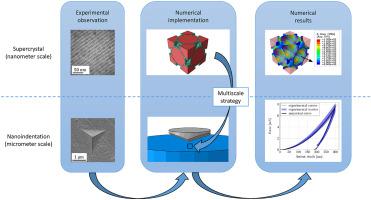当前位置:
X-MOL 学术
›
Compos. Sci. Technol.
›
论文详情
Our official English website, www.x-mol.net, welcomes your
feedback! (Note: you will need to create a separate account there.)
Ultra-thin and ultra-strong organic interphase in nanocomposites with supercrystalline particle arrangement: Mechanical behavior identification via multiscale numerical modeling
Composites Science and Technology ( IF 8.3 ) Pub Date : 2020-09-01 , DOI: 10.1016/j.compscitech.2020.108283 Mingjing Li , Ingo Scheider , Büsra Bor , Berta Domènech , Gerold A. Schneider , Diletta Giuntini
Composites Science and Technology ( IF 8.3 ) Pub Date : 2020-09-01 , DOI: 10.1016/j.compscitech.2020.108283 Mingjing Li , Ingo Scheider , Büsra Bor , Berta Domènech , Gerold A. Schneider , Diletta Giuntini

|
Abstract A key challenge in the development of inorganic-organic nanocomposites is the mechanical behavior identification of the organic phase. For supercrystalline materials, in which the organic phase ranges down to sub-nm areas, the identification of the organic materials' mechanical properties is however experimentally inaccessible. The supercrystalline nanocomposites investigated here are 3D superlattices of self-assembled iron oxide nanoparticles, surface-functionalized with crosslinked oleic acid ligands. They exhibit the highest reported values of Young's modulus, nanohardness and strength for inorganic-organic nanocomposites. A multiscale numerical modeling approach is developed to identify these properties using supercrystalline representative volume elements, in which the nanoparticles are arranged in a face-centered cubic superlattice and the organic phase is modeled as a thin layer interfacing each particle. A Drucker-Prager-type elastoplastic constitutive law with perfectly plastic yielding is identified as being able to describe the supercrystals' response in nanoindentation accurately. As the nanoparticles behave in a purely elastic manner with very high stiffness, the underlying constitutive law of the organic phase is also identified to be Drucker-Prager-type elastoplastic, with a Young's modulus of 13 GPa and a uniaxial tensile yield stress of 900 MPa , remarkably high values for an organic material, and matching well with experimental and DFT-based estimations. Furthermore, a sensitivity study indicates that small configurational changes within the supercrystalline lattice do not significantly alter the overall stiffness behavior. Multiscale numerical modeling is thus proven to be able to identify the nanomechanical properties of supercrystals, and can ultimately be used to tailor these materials' mechanical behavior starting from superlattice considerations.
中文翻译:

具有超晶颗粒排列的纳米复合材料中的超薄和超强有机中间相:通过多尺度数值模拟的力学行为识别
摘要 开发无机-有机纳米复合材料的一个关键挑战是有机相的力学行为鉴定。然而,对于有机相范围低至亚纳米区域的超晶材料,有机材料的机械性能的鉴定在实验上是无法实现的。这里研究的超晶纳米复合材料是自组装氧化铁纳米颗粒的 3D 超晶格,表面用交联油酸配体进行了功能化。对于无机-有机纳米复合材料,它们表现出最高的杨氏模量、纳米硬度和强度报告值。开发了一种多尺度数值建模方法,以使用超晶代表性体积元素来识别这些特性,其中纳米颗粒排列在面心立方超晶格中,有机相被建模为与每个颗粒连接的薄层。具有完美塑性屈服的 Drucker-Prager 型弹塑性本构定律被确定为能够准确描述纳米压痕中超晶的响应。由于纳米粒子以具有非常高刚度的纯弹性方式表现,因此有机相的基本本构法则也被确定为 Drucker-Prager 型弹塑性,杨氏模量为 13 GPa,单轴拉伸屈服应力为 900 MPa ,对于有机材料来说非常高的值,并且与实验和基于 DFT 的估计很好地匹配。此外,一项敏感性研究表明,超晶格内的微小构型变化不会显着改变整体刚度行为。因此,多尺度数值建模被证明能够识别超晶的纳米力学特性,并最终可用于从超晶格考虑出发来定制这些材料的力学行为。
更新日期:2020-09-01
中文翻译:

具有超晶颗粒排列的纳米复合材料中的超薄和超强有机中间相:通过多尺度数值模拟的力学行为识别
摘要 开发无机-有机纳米复合材料的一个关键挑战是有机相的力学行为鉴定。然而,对于有机相范围低至亚纳米区域的超晶材料,有机材料的机械性能的鉴定在实验上是无法实现的。这里研究的超晶纳米复合材料是自组装氧化铁纳米颗粒的 3D 超晶格,表面用交联油酸配体进行了功能化。对于无机-有机纳米复合材料,它们表现出最高的杨氏模量、纳米硬度和强度报告值。开发了一种多尺度数值建模方法,以使用超晶代表性体积元素来识别这些特性,其中纳米颗粒排列在面心立方超晶格中,有机相被建模为与每个颗粒连接的薄层。具有完美塑性屈服的 Drucker-Prager 型弹塑性本构定律被确定为能够准确描述纳米压痕中超晶的响应。由于纳米粒子以具有非常高刚度的纯弹性方式表现,因此有机相的基本本构法则也被确定为 Drucker-Prager 型弹塑性,杨氏模量为 13 GPa,单轴拉伸屈服应力为 900 MPa ,对于有机材料来说非常高的值,并且与实验和基于 DFT 的估计很好地匹配。此外,一项敏感性研究表明,超晶格内的微小构型变化不会显着改变整体刚度行为。因此,多尺度数值建模被证明能够识别超晶的纳米力学特性,并最终可用于从超晶格考虑出发来定制这些材料的力学行为。









































 京公网安备 11010802027423号
京公网安备 11010802027423号